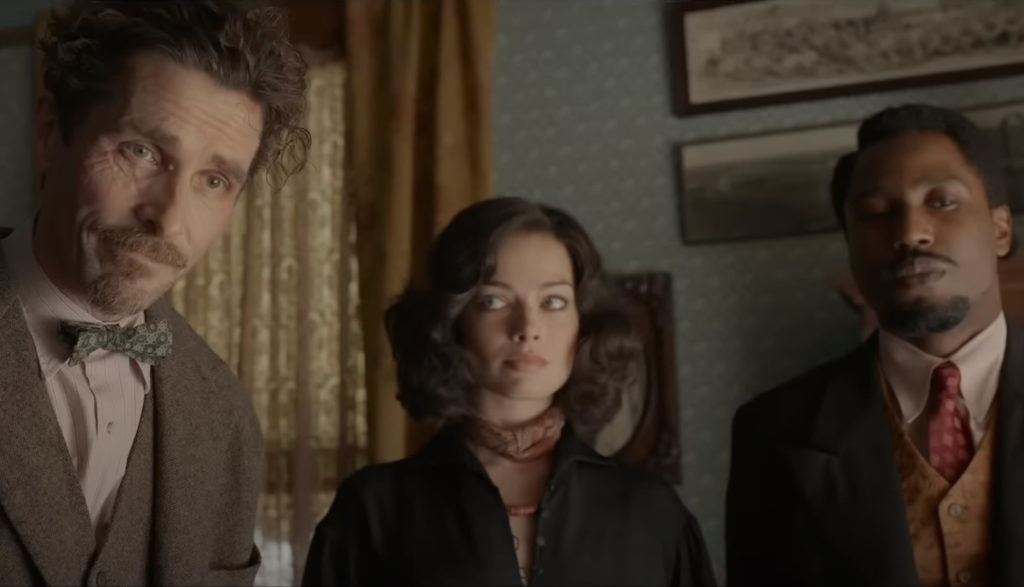
Burt Berendsen signed up for the Great War to get something: a medal, perhaps. The respect of his well-heeled in-laws. The increased ardor of his society-conscious wife, Beatrice.
But wars aren’t known for their generosity. The conflict took his eye, his looks, his health and his prospects. In exchange, it only gave him scars and a wicked back brace. His in-laws promptly kicked him out of the family house. Rare visits with Beatrice are chilly.
But then again, maybe the war wasn’t all bad. It did give the young doctor a pair of good friends.
Harold Woodman served under Burt, who was about the only white officer willing to lead a company of Black men into battle. They carried each other through the war (sometimes literally), saving each other’s life many a time. They met Valerie in Amsterdam: She nursed them both back to health. She fell in love with Harold. And for a few months, the three were inseparable.
But Burt couldn’t stay in Amsterdam forever. And so the trio split.
Nearly 15 years later, and Valerie’s long gone—vanished, it would seem, without a whisper. But Burt and Harold are still tight: Burt’s a doctor, Harold’s a lawyer, and together they do what they can to help other vets put their lives back in order and pick up the pieces of their lives.
But that was before they saw the body.
It was that of Gen. Bill Meekins, their old wartime commander, and good an officer as you could hope to serve under. And here’s the thing: He shouldn’t be dead, his beautiful daughter insists. She wants Burt to find out if he was murdered.
Burt agrees. Reluctantly. But before the day is out, it’s he and Harold who’ll be suspected of murder—and to clear their names, they’ll need to find the real killer and, perhaps, uncover a ludicrously complicated plot.
It’s 1933. And yet the Great War keeps on giving … and taking.
Whatever its other faults, Amsterdam does give you a collection of people trying to do the right thing.
Take Burt, our intrepid, one-eyed doctor. In the war, he bucks the racism of the day and agrees to lead Harold and other Black men into battle. Back home, he dedicates his days to patching up fellow vets—giving them the ability to cover their wounds and to live in society as well as can be expected. He could’ve had a much easier life and more lucrative practice had he refused to work with these vets (especially those of American minorities). But he won’t turn his braced back on them.
While Burt patches wounds, Harold works to help vets in the legal realm. After the war he becomes a lawyer—presumably a rare profession for an African American man in 1933—and works tirelessly to defend veterans’ rights. He and Burt run an annual charity gala for the people they served with, and it’s clearly a passion for both of them.
Valerie also does brave work during the war—doing her best to patch up and help heal many a wounded soldier. And all three of them made a pact to protect one another as best they can.
When the three of them get embroiled in the circumstances over Gen. Meeker’s death, they do so in part to clear their own names. But there’s more to it, as well: They want to know why a good man was murdered. And while they all know that the country they sacrificed so much for isn’t perfect, they also continue to serve it, doing their upmost to preserve what makes it special.
During the war, Valerie clashes with a priest over her desire to keep the shrapnel she collects from soldiers’ wounds. The priest (brandishing a Bible for emphasis) argues that to keep those jagged hunks of metal amounts to blasphemy. Valerie insists, “I redeem it when it comes out.” (Valerie, with support from Harold and Burt, eventually gets her way.)
We hear several passing references to God and faith: Burt mentions that he’s half-Christian, half-Jewish. We hear other references to Jewish people, often those expressing some anti-Semitic views.
People wonder if they “followed the wrong god home,” a way of speculating as to whether their priorities were, or are, out of whack.
Valerie and Harold fall in love in Amsterdam. We see the two in bed together (Valerie’s exposed back faces the camera), and they kiss elsewhere. Marriage doesn’t seem to be a consideration for either of them—in part, perhaps, because their interracial relationship wouldn’t be accepted back in the States. “We only exist in Amsterdam,” Valerie tells Harold when he discusses returning to America.
Burt is married to the well-to-do Beatrice. But because Beatrice’s parents don’t approve of Burt, and Beatrice is more interested with her relationship with them (and her social standing) than her relationship with him, they barely see each other. Burt continues to hold out hope for reconciliation for most of the movie: When she issues a rare invitation to him, Burt brings flowers and a book of poetry in an effort to rekindle their old love. But Beatrice seems to harbor a perverse interest in Burt’s old war wounds. She makes him take off his shirt so she can see the scars on his back, telling him how disgusting and horrific he looks now.
Burt finds himself attracted to a skilled nurse/physician named Irma, and Harold actively encourages Burt to forget Beatrice and turn his attention to her. Burt at first refuses, but the door appears to open as the movie goes on.
A married woman clearly has a crush on a retired general. And when she meets the General, she clasps his hand and holds it close to her bosom (as her husband awkwardly watches). Some revealing eveningwear is seen.
Gen. Meeker undergoes an extremely graphic autopsy, complete with organs, bones, blood and other bodily fluids.
A woman is pushed into the street and run over by a car. Another woman has her wrist broken; a doctor corrects how the broken bone was set, and the reset is clearly painful. A fantasy sequence depicts two people shot by the same bullet. (Judging by the bloody injuries, the bullet passed through a man’s neck and entered a woman’s cheek.) Someone gets shot. There’s an assassination attempt.
The wartime trauma that both Burt and Harold suffer is traumatic indeed. Both scream in agony as they’re wheeled into the hospital. The camera shows us why, documenting their many, many bloody wounds (including some severe ones on their respective faces). When Valerie digs into those wounds to pull out shrapnel, we see it all—in addition to how painful it must be.
Both bear some bad scars as a result of their wartime experiences. Burt’s are the most obvious and most debilitating. He lost his eye (and frequently loses his glass one), and he covers the worst of his facial injuries with what appears to be a bit of patchwork plastic. As mentioned, his wife loves/hates looking at the scars on his back (which we also see), and the brace he wears causes its own sorts of pain. (We see bruises and places where the skin has been rubbed raw.) He also tries to cover other vets’ facial wounds with artificial skin, though their underlying scars are left up to the viewers’ imaginations.
We hear a tale of how the Italian dictator Mussolini ran over a child and didn’t bother to stop. Burt believes that his in-laws might’ve encouraged him to fight in the world war to “get rid of me.” Valerie tells how she once needed to bean another woman with a brick. We see people fight, and someone’s slugged in the face.
One f-word, four s-words and a peppering of other profanities, including “a–,” “b–ch,” “b–tard,” “d–n,” “h—” and the British profanity “b–locks.” We hear the racial epithet “cracker.” God’s name is misused about a dozen times.
Burt is always looking for something to numb the pain that he and his patients feel, and he’ll try just about any experimental medication he comes in contact with. Some of these drugs are stronger than others, naturally, and at least one drug causes him to pass right out.
The most effective drugs that Burt takes during the movie are some eyedrops that not only deaden pain but melt away any anxious thoughts the user might be having. The drops are so effective that Burt seems barely fazed when he’s shot.
[Spoiler Warning] When Burt and Harold reunite with Valerie, they find her living with her well-to-do family. She’s sick, her family says, and they keep her both sequestered to the house and in the thrall of a number of drugs that, she’s told, are meant to help her. (We’re eventually led to believe that Valerie’s not sick at all, and the drugs are a way to keep her somewhat malleable and dependent on them.) Later, as she staggers around the street and struggles to reach the front door of a retired general’s house, the general’s wife believes she’s drunk, not sick. (And she’s not drunk. But whether the staggering is a sign of an actual illness or the drugs she’s been given to combat her fictional illness, we don’t know.)
People drink, sometimes to apparent excess. Valerie and Harold discover a secret lab where drugs are made.
Harold, Burt, Valerie and others must deal with racism, sexism and anti-Semitism. The movie obviously doesn’t condone any of those “isms,” but they are unescapable themes.
We’re told that Valerie’s far more skilled at forging documents than either Harold or Burt.
Our three heroes uncover a massive, well-funded plot to overthrow the government.
It boasts an Oscar-nominated director in David O. Russell. It features a baseball team’s worth of A-list stars. And yet, Amsterdam is kind of a mess as a movie.
Part screwball comedy, part murder mystery, part political thriller, part social commentary, Amsterdam never locks onto one bullseye and pulls the trigger. Instead, it fires its shots in all directions—like Burt himself might do if he took too much of his “experimental medication” and was also wrestling with a couple of secret fascist agents.
And yet for all that, the film has its strong points, too.
Certainly none of our three heroes are perfect, and they’d all fall well short of how we’d like them to behave. But they have a strong sense of right and wrong, as well. Sometimes that morality feels rather old-fashioned (its commitment to honoring veterans and preserving the good ol’ U.S.A.), sometimes it feels nicely contemporary (their push against the age’s biases and bigotries).
It’s rather too bad that Amsterdam reveled in other excesses, of course, instead of honing its focus more. Amsterdam is rated R, and it earns that restrictive rating via its sometimes grotesque, gory imagery.
The real Amsterdam is actually built below sea level. It requires a complex system of walls and pumps to keep the sea at bay. Seems fitting that a movie named after this beautiful city should indeed boast so much glitter—and yet still be all wet.


Paul Asay has been part of the Plugged In staff since 2007, watching and reviewing roughly 15 quintillion movies and television shows. He’s written for a number of other publications, too, including Time, The Washington Post and Christianity Today. The author of several books, Paul loves to find spirituality in unexpected places, including popular entertainment, and he loves all things superhero. His vices include James Bond films, Mountain Dew and terrible B-grade movies. He’s married, has two children and a neurotic dog, runs marathons on occasion and hopes to someday own his own tuxedo. Feel free to follow him on Twitter @AsayPaul.
Our weekly newsletter will keep you in the loop on the biggest things happening in entertainment and technology. Sign up today, and we’ll send you a chapter from the new Plugged In book, Becoming a Screen-Savvy Family, that focuses on how to implement a “screentime reset” in your family!